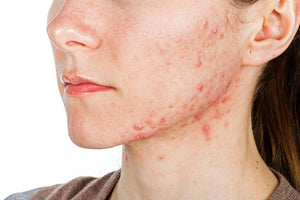Biofilms and skin disorders
November 14, 2018

What are biofilms?
Biofilms are diverse communities of microorganisms (e.g. bacteria, fungi and yeasts) that embed themselves within a self-produced matrix and in doing so firmly attached themselves to one another and/or to surfaces. These surfaces may be biological (e.g. skin, wounds, teeth, or other body membranes), or not (e.g. implements, medical devices, furniture, or jewellery). The biofilm promotes the growth of the microorganisms, resulting in the thickening of the biofilm. In extreme cases, biofilms may appear as a “slime” to the naked eye.
Why are biofilms important?
Biofilms may harbour disease-causing organisms. According to one estimate, up to 80% of all microbial infections involve biofilm formation (1). If an infection develops a biofilm, it becomes even harder to treat. Biofilms are remarkably difficult to treat with antimicrobials, but the reasons for this are not clear. Antimicrobials may be inactivated or may fail to penetrate into the biofilm. In addition, bacteria within biofilms have increased (up to 1000-fold higher) resistance to antimicrobial compounds, and to the body’s defences (1, 2). Due to their embeddedness and resistance, biofilms often prove difficult to remove.
It has been suggested that skin biofilms may explain the chronic nature of many dermatological conditions, including atopic dermatitis, poor wound healing, acne, Candida infections, impetigo and boils (3).
How to remove biofilms
There are a number of approaches to reduce the impact of biofilms and help the skin return to its normal healthy state. Contact Border Compounding Pharmacy and talk to a pharmacist to learn more about this fascinating area of skincare.
References
-
“Research on microbial biofilms (PA-03-047)”. NIH, National Heart, Lung, and Blood Institute. 2002-12-20.
- Bryers, JD (2008) Medical biofilms. Biotechnology and Bioengineering, 100(1): 1-18.
- Nusbaum AG, et al. (2012) Biofilms in Dermatology. Skin Therapy Letters, 17(7):1. (http://www.skintherapyletter.com/2012/17.7/1.html)
-
Raad I, et al. (2003) In Vitro and Ex Vivo Activities of Minocycline and EDTA against Microorganisms Embedded in Biofilm on Catheter Surfaces. Antimicrobial Agents and Chemotherapy 47(11): 3580–3585.
- Banin E, et al. (2006) Chelator-Induced Dispersal and Killing of Pseudomonas aeruginosa Cells in a Biofilm. Appl Environ Microbiol.72(3): 2064–2069.
- Robertson EJ, et al. (2012) EDTA Inhibits Biofilm Formation, Extracellular Vesicular Secretion, and Shedding of the Capsular Polysaccharide Glucuronoxylomannan by Cryptococcus neoformans. Appl. Environ. Microbiol. 78(22): 7977-7984
- Kadry AA, et al. (2009). Impact of slime dispersants and anti-adhesives on in vitro biofilm formation of Staphylococcus epidermidis on intraocular lenses and on antibiotic activities. Journal of Antimicrobial Chemotherapy. 63 (3): 480.
- Thomsen TR, et al. (2011) The role of bacterial biofilms in infections of catheters and shunts. In: Bjarnsholt Thomas., editor; , Jensen Peter Østrup., editor; Moser Claus., editor; , Høiby Niels., editor. , eds. Biofilm Infections. New York: Springer. pp 91–109.
- Stoodley P, et al. (2012) Biofilms, biomaterials, and device-related infections. In: Ratner BD, editor; , Hoffman AS, editor; , Schoen FJ, editor; , Lemons JE, editor. , eds. Biomaterials Science an Introduction to Materials in Medicine, 3rd ed. Oxford, UK: Elsevier, pp 565–583.
- Lambert RJW, et al. (2004) The synergistic effect of EDTA/antimicrobial combinations on Pseudomonas aeruginosa. J. Appl. Microbiol.96:244–253.
- Finnegan S and Percival SL (2015) EDTA: An Antimicrobial and Antibiofilm Agent for Use in Wound Care. Adv Wound Care (New Rochelle). 4(7): 415–421.
Leave a comment
Comments will be approved before showing up.


